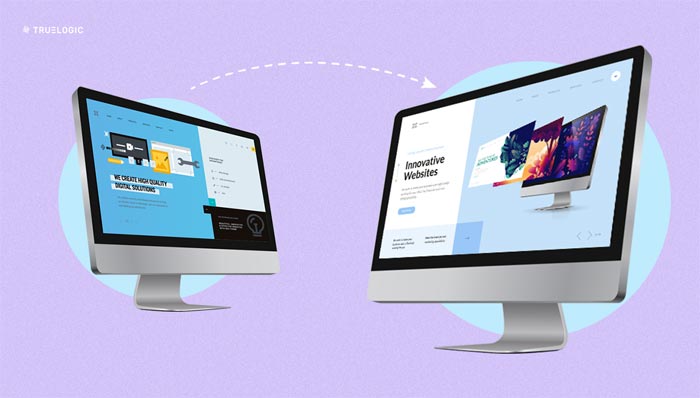A Strategic Guide to Redesigning Your Website

Redesigning a website is more than just a visual facelift—it’s an opportunity to modernize your digital presence, realign with your business goals, and elevate user experience. Just like renovating a home, a website redesign should be driven by clear objectives, strategic planning, and careful execution.
At Truelogic, we treat website redesigns as both a technical and marketing initiative. Our approach focuses on design, performance, and most importantly—your long-term success in the digital space. Whether you’re updating your brand, improving site speed, or enhancing mobile usability, the right redesign can lead to measurable gains in traffic, conversions, and customer trust.
Why You Might Need a Website Redesign
Many businesses wait too long to refresh their website. Others redesign too frequently without a strategy. A successful redesign starts with identifying legitimate reasons, not just cosmetic preferences.
Here are common, valid reasons for redesigning your website:
1. You’re Rebranding
If your company is undergoing a rebrand—changing its visual identity, messaging, or market positioning—your website should reflect that shift. Consistency across your digital touchpoints is critical. Updating your website ensures your brand experience feels unified and professional.
2. You’ve Outgrown Your Current Website
As your business grows, so do your needs. You may need to support more users, add new services, or expand your product offerings. A redesign lets you build in new functionality (e.g., multilingual content, appointment systems, gated content) while maintaining a smooth user experience.
3. Sales or Conversions Are Declining
If your analytics show a drop in leads or purchases, your website could be part of the problem. Cluttered design, slow loading times, confusing navigation, or mobile usability issues often contribute to lost revenue. A smart redesign fixes these pain points and sets up better conversion pathways.
4. You’re Not Mobile-Ready
With over 50% of global web traffic coming from mobile devices, your website must perform flawlessly on smartphones and tablets. If your site isn’t mobile-responsive—or only partially—then a redesign isn’t just a good idea; it’s urgent.
5. You’re Falling Behind on SEO
Google’s algorithms now factor in user experience, site speed, mobile usability, and structure. If your rankings are slipping, outdated design or technical limitations may be to blame. A redesign that includes SEO upgrades can help you regain visibility and drive organic traffic.
Why You Might Need a Website Redesign
Set Clear Business Goals
A website redesign should always support specific business objectives. Do you want to increase leads? Improve conversions? Streamline your e-commerce experience? Before you touch the layout or wireframes, clarify your goals. Everything else should follow from these.
Understand Your Users
User experience (UX) is central to any redesign. Use analytics tools, heatmaps, and surveys to understand user behavior—what they’re looking for, where they drop off, and how they interact with your content. Let the data guide your UX decisions, not just aesthetics.
Audit Your Existing Website
Before you rebuild, evaluate what works and what doesn’t. Which pages perform well? What content gets shared? Which landing pages have high bounce rates? This helps you avoid discarding valuable assets during the redesign.
Key Elements of a High-Performing Redesign
1. Mobile-First, Always
Design your new site with mobile users as the priority. Mobile-first design ensures faster load times, thumb-friendly navigation, and a streamlined layout—critical for conversions on smaller screens.
2. Intuitive Navigation
Simplify your site architecture. Limit menu items, group similar content, and make it easy for users to find what they need in three clicks or less. This improves UX and helps search engines crawl your site more effectively.
3. Fast Load Speeds
Slow websites lose users. Use image compression, clean code, and lazy loading to boost speed. Consider a performance audit as part of the redesign process to remove bloat and streamline delivery.
4. Visual Consistency
Your design should reinforce your branding—fonts, colors, spacing, and image style should all work together. Good design builds trust and keeps users engaged longer.
5. Smart Use of White Space
Cluttered pages overwhelm visitors. Strategic white space improves readability, draws attention to key messages, and enhances overall UX.
6. Interactive Features (When Relevant)
Use forms, calculators, sliders, or videos to keep users engaged. But don’t overdo it—every element should support the user’s intent.
The SEO Side of Website Redesigns
Redesigns have major SEO implications. Without careful planning, you can lose rankings, backlinks, and organic traffic. Here’s how to protect your SEO value:
Implement Proper Redirects (301s)
If any URLs are changing, set up 301 redirects to tell search engines (and users) where the new content lives. This preserves link equity and prevents 404 errors. Skipping this step can lead to major ranking drops.
Maintain High-Value Content
Don’t delete or rewrite your top-performing content without cause. Use analytics to identify high-traffic pages, then preserve or enhance them in your new layout.
Reassess Site Structure and Internal Linking
Rebuild your site with a logical URL hierarchy and strong internal links. This helps users find what they need and assists Google in understanding the importance of each page.
Update Your XML Sitemap and Robots.txt
Once your redesign is complete, update your XML sitemap and robots.txt file. Submit the new sitemap to Google Search Console to speed up indexing.
Test Everything Before Going Live
Once your redesign is complete, update your XML sitemap and robots.txt file. Submit the new sitemap to Google Search Console to speed up indexing.
Content Strategy for a Redesigned Website
Redesigns are a great time to revisit your content. Here’s how to align your copy with performance goals:
Prioritize Content That Converts
Audit your content for relevance and value. Remove outdated pages, combine overlapping ones, and refresh older blogs with new data.
Align with User Intent
Make sure each page matches what users are searching for. Use clear headers, helpful subheadings, and calls-to-action that reflect real customer questions or needs.
Use an SEO-Friendly CMS
Choose a CMS that supports clean URLs, metadata control, responsive design, and easy content updates. WordPress, Webflow, and Shopify are great choices for most businesses.
Optimize Media and File Sizes
Large images and videos can slow your site down. Use proper formats (e.g., WebP) and compression tools to maintain quality without hurting speed.
Measuring the Success of Your Redesign
A successful redesign isn’t just pretty—it performs. Here’s how to measure the ROI of your redesign:
Use tools like Google Analytics, Search Console, Hotjar, and PageSpeed Insights to track performance over time.
A website redesign is your chance to improve every aspect of your online presence—from visual identity and user experience to SEO performance and lead generation. But success lies in the strategy. Don’t just redesign for aesthetics—redesign for results.
Treat your next website refresh as an investment, not a cost. With the right plan, the right team, and the right execution, you won’t just keep up—you’ll move ahead.









